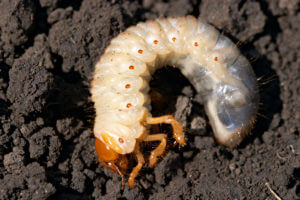Grubs — they’re almost as ugly as the damage they cause. These pests are so sneaky it’s often difficult to even know they’re doing damage until it’s too late. To add insult to injury, grubs tend to congregate in healthy lawns where turf roots are thick and juicy.
Grubs are actually larvae of beetles. Most are off-white with brown heads, and known by the “C” position they take when disturbed. Grubs overwinter underground and begin feeding on turf roots in spring and summer.

Grub feeding leaves irregular brown patches and the lawn may have a spongy feel. Sod will roll up like loose carpet if the roots are already destroyed. The only way to know for sure though, is to gently pull up a small section of sod. If you see more than four grubs per square foot, you have a problem. Lawns with severe grubs can have 40-60 per square foot.
While curative treatments go after grubs that are already present and active, preventative treatments offer the best solution whenever possible. If you suspect that you may have grubs, give Munie a call. We’ll come out and evaluate your lawn and recommend the best treatment possible based on the grubs’ current status
If left to thrive, grubs can do an incredible amount of damage to your lawn. With the right treatments, Munie will see that you get rid of the grubs you have now while preventing future invasions.






